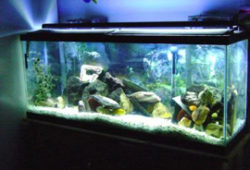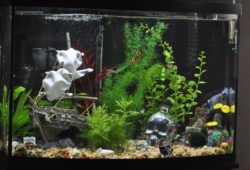Filters For Aquarium
The article gives an analysis of Filters For Aquarium. If you’re putting in place an interior aquarium for the primary time, a filtration device is one in every of the most necessary pieces of equipment you may purchase. Filters are required for both freshwater and marine (saltwater) ecosystems; they take away physical and chemical waste from the water. As a result of an aquarium is an inside environment, these waste merchandise and harmful chemicals haven’t any means of natural dispersion, and therefore must be physically removed. Filters are important in supporting the life systems in your aquarium, whether fish, plants, or invertebrates.

Decomposing organic matter, as well as excreta from fish, manufacture ammonia, which is toxic to fish. In the plants, ammonia is oxidized into nitrites through bacterial processes; nitrites are then more oxidized into abundant less toxic nitrates, which in turn naturally fertilize marine plant life. As a result of most aquariums have unnaturally large concentrations of fish, however, excessive amounts of ammonia are routinely made, and the accumulation of toxic ammonia in aquariums is the most important reason for fish mortality in these closed environments.
There are three basic ways of aquarium filtration: biological, mechanical, and chemical. Biological filtration makes an attempt to most closely recreate what happens within the natural world; these filters promote the growth of bacteria that propel the oxidation method forward. A basic biological filter may merely be a chemically inert, porous sponge, which provides an enlarged surface space for colonies of bacteria to develop. Initially, it create take many weeks for the colonies to create, leaving an aquarium at risk of ammonia buildup within the meantime. If a tank is stocked with fish too quickly, it may suffer from “new tank syndrome,” in that the propagation of bacteria cannot initially maintain with the assembly of ammonia, and fish can fall ill or die.
One in style biological filter is an “undergravel filter”: a porous plate that’s laid underneath the substrate in your aquarium, with a number of uplift tubes. Air stones placed beneath the uplift tubes force water out, making negative pressure beneath the filter plate. Water then percolates downward through the substrate layer, which is colonized by bacteria and so acts because the filtration material. A water pump will accelerate the filtration process. However, such filters may not work with fine substrates such as sand or peat; gravel works better. Additionally, the substrate layer should be level, to ensure even water flow through the entire substrate; if you propose to stay marine animals that dig into the substrate layer, an undergravel filter might not be suitable.
Another kind of biological filtration system is the trickle filter, or “wet-dry filter.” Normally, these filters are placed above the aquarium. Water is pumped over a series of perforated trays containing filter wool, or another filter material. As water trickles through the trays, the filter wool is kept wet but not submerged, encouraging the growth of aerobic bacteria colonies that oxidize the ammonia within the water. The water drips backtrack into the tank once it has suffered the trays.
Mechanical filtration physically removes particulate material from the water; this is often achieved by passing the water through a sieve, trapping uneaten food, excreta, plant debris, and alternative waste matter. This solid waste should be removed from the filter on a regular basis (weekly), before it will decay and dissolve back to your tank. The most common form of mechanical filtration is thru a canister filter, that sometimes hangs on the back of the tank. Water is pumped in, saw no matter filter material is employed, and then pumped into the tank. These filters can process giant quantities of water quickly, and they are simple to remove and clean. But, mechanical filtration through a canister will not take away dissolved ammonia, microscopic bacteria or algae, or solids trapped by gravel, plants, or aquarium decorations.
A protein skimmer is the simplest form of mechanical filtration for a saltwater tank. The motion created by the skimmer injects air bubbles into the tank, creating a foam similar to sea foam. Organic molecules collect in this foam, that is captured in a very collection cup. This method of filtration removes dissolved organic compounds before they break down into ammonia and nitrites.
Chemical filtration aims to remove dissolved wastes from your tank’s water. To some extent, the marine plants in your tank extract dissolved waste from the water as they grow, acting as natural filters. Chemical filtration strategies, most typically using activated carbon, aid in this effort. The carbon’s microporous structure absorbs dissolved organic materials, toxic metals and gasses, growth-inhibiting enzymes, and other harmful elements. The carbon ought to be positioned in the tank such that water passes through it, not simply over it; the carbon also desires to be replaced periodically.
There are various other substances that you’ll introduce into your tank to get rid of specific resins or minerals, if you expertise a buildup of some undesirable element. Varied treated sponges will take away phosphates, nitrates, and different minerals. You’d want to test your water to work out if it contains excessive amounts of any harmful materials.
Your selection of filter will rely on how much ecosystem you’re creating in your aquarium; you will would like to use a selection of filtration devices to make sure a clean and healthy setting for your fish and plant life.



